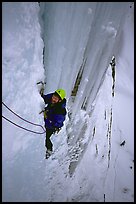
My first week in the Canadian Rockies
Q.-Tuan Luong
Berkeley, March 28, 1994
A short report to complement the
photos.
I just returned from an ice-climbing trip to the Banff-Jasper
highway with Jim Frankelfied from Cornvallis, Oregon. The setting
is Canadian rockies, in Banff national park. It is a very beautiful
and impressive area with a lot of high mountains around. It is also
quite remote. The only facilities available within 2 hours drive are a
gas station and a restaurant and souvenir shop. The place where every
climber (and only climbers) stays is Rampart Creek Hostel, which is
more like a climber's hut (no running water, no electricity). It is
good to stock groceries before heading to the park.
Among others, we
climbed Curtain Calls (partly), the lower Weeping Wall, and Polar
Circus.
- Curtain Calls:
- This is a two long pitch (or
three short pitch) climb, which is on a huge and steep icicle. In my
opinion, the rating is III-5+. Apart from the base, the climb is very
sustained. There was a lot of water, and since it was chandelier ice,
placements were not too good. Other climbs in the area also suffer
from this problem. This is characteristic of the late season, and
should not happen in Jan/Feb.
- Weeping Wall:
- This has been
called a vertical football field. There are two parts, which are quite
far apart, is spite of the deceiving perspective. The upper part is more
difficult and involves grade 6 ice with hanging belays, so we passed on
it because the conditions did not seem good enough. The lower part is much
more frequently done, and by itself it is a worthwhile climb. The approach is
only 5 minutes from the Icefields parkway.
It is amazing because it is
so wide, you have the feeling to be on a vertical glacier, which is
very rare elsewhere. As a consequence, there is several routes which
can be done. The most interesting is the central pillar (III-5/5+),
which was not in excellent condition. You have to belay on the
headwall for this climb, so we did instead a line on the right
(III-5), which has a fixed belay before the headwall.
So only the right lower part was in (relatively) good ice,
although I found that the crux pitch was again quite wet and chandeliered
(more chandeliered than Curtain Calls but fortunately less wet). The
left part has rotten ice on the surface, and the upper Wall was neither too
good. There seems to be two factors which contribute to this situation:
first, warm temperatures the previous week, followed by (relatively) cold
temperatures the week we were there, and second, exposure to the sun.
By contrast, climbs which are in the shadow seemed to be in better conditions.
Since pro was not entirely reliable, we prefered not to do the Pilar, for
which hanging belay(s) are required, especially since I have heard before
horror stories about this climb.
- Polar Circus:
- This is a rather long climb (total 500 meters). The begining is an
alternance of snow gullies and pitch-long frozen waterfalls, some of them
you can bypass. The final part is quite sustained and consists of an headwall
of 4 or 5 pitches with short vertical sections (IV-5). The deep gorge
between huge rock walls create a beautiful atmosphere. We found
excellent ice, but we were struck by a rather important
avalanche in the last pitch and even lost a pack that we left at the base
of the terminal headwall. Before this headwall, there is also avalanche
slopes to be traversed, on which we found the snow to be rather
untransformed. Note that the day of our climb happened to be the first of
really sunny weather after a snowfall one week before.
According to the specialists of the area, it was average conditions for that
period of the year. There has been better conditions (some major climbs were
not formed) but also much worse. Two years ago, at end of March, the Weeping
Wall was not even here, and in 1987 ice was rotten everywhere (to the extend
that two of the best ice climbers, Damilano and Perroux, were totally scared).
The conclusion is that for more consistent conditions it is probably better to
come earlier in the season.

